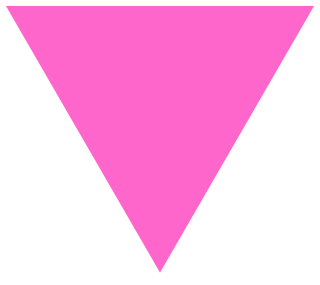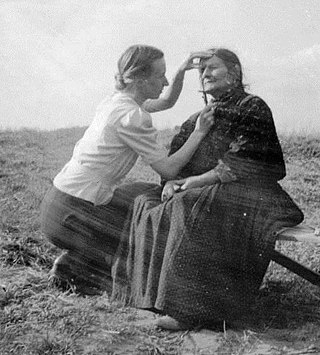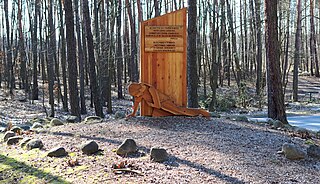
A pink triangle has been a symbol for the LGBT community, initially intended as a badge of shame, but later reclaimed as a positive symbol of self-identity. In Nazi Germany in the 1930s and 1940s, it began as one of the Nazi concentration camp badges, distinguishing those imprisoned because they had been identified by authorities as gay men. In the 1970s, it was revived as a symbol of protest against homophobia, and has since been adopted by the larger LGBT community as a popular symbol of LGBT pride and the LGBT movements and queer liberation movements.

The Romani Holocaust or the Romani genocide was the planned effort by Nazi Germany and its World War II allies and collaborators to commit ethnic cleansing and eventually genocide against European Roma and Sinti peoples during the Holocaust era.

The Sinti are a subgroup of Romani people. They are found mostly in Germany, France and Italy and Central Europe, numbering some 200,000 people. They were traditionally itinerant, but today only a small percentage of Sinti remain unsettled. In earlier times, they frequently lived on the outskirts of communities.
The Romani people have long been a part of the collective mythology of the West, where they were depicted as outsiders, aliens, and a threat. For centuries they were enslaved in Eastern Europe and hunted in Western Europe: the Pořajmos, Hitler's attempt at genocide, was one violent link in a chain of persecution that encompassed countries generally considered more tolerant of minorities, such as the United Kingdom. Even today, while there is a surge of Romani self-identification and pride, restrictive measures are being debated and passed by democratic states to curb the rights of the Romani people.

Nazi concentration camp badges, primarily triangles, were part of the system of identification in German camps. They were used in the concentration camps in the German-occupied countries to identify the reason the prisoners had been placed there. The triangles were made of fabric and were sewn on jackets and trousers of the prisoners. These mandatory badges of shame had specific meanings indicated by their colour and shape. Such emblems helped guards assign tasks to the detainees. For example, a guard at a glance could see if someone was a convicted criminal and thus likely of a tough temperament suitable for kapo duty.

The Nuremberg Laws were antisemitic and racist laws that were enacted in Nazi Germany on 15 September 1935, at a special meeting of the Reichstag convened during the annual Nuremberg Rally of the Nazi Party. The two laws were the Law for the Protection of German Blood and German Honour, which forbade marriages and extramarital intercourse between Jews and Germans and the employment of German females under 45 in Jewish households; and the Reich Citizenship Law, which declared that only those of German or related blood were eligible to be Reich citizens. The remainder were classed as state subjects without any citizenship rights. A supplementary decree outlining the definition of who was Jewish was passed on 14 November, and the Reich Citizenship Law officially came into force on that date. The laws were expanded on 26 November 1935 to include Romani and Black people. This supplementary decree defined Romanis as "enemies of the race-based state", the same category as Jews.

Lety concentration camp was a World War II internment camp for Romani people from Bohemia and Moravia during the German occupation of Czechoslovakia. It was located in Lety.

Robert Ritter was a German racial scientist doctor of psychology and medicine, with a background in child psychiatry and the biology of criminality. In 1936, Ritter was appointed head of the Racial Hygiene and Demographic Biology Research Unit of Nazi Germany's Criminal Police, to establish the genealogical histories of the German "Gypsies", both Roma and Sinti, and became the "architect of the experiments Roma and Sinti were subjected to." His pseudo-scientific "research" in classifying these populations of Germany aided the Nazi government in their systematic persecution toward a goal of "racial purity".

The Romani flag or the flag of the Roma is the international ethnic flag of the Romani people, historically known as "Gypsies", which form a stateless minority in countries across Eurasia, Africa, the Americas, and Australasia. It was approved by the representatives of various Romani communities at the first and second World Romani Congresses (WRC), in 1971 and 1978. The flag consists of a background of blue and green, representing the heavens and earth, respectively; it also contains a 16-spoke red dharmachakra, or cartwheel, in the center. The latter element stands for the itinerant tradition of the Romani people and is also an homage to the flag of India, added to the flag by scholar Weer Rajendra Rishi. It superseded a number of tribal emblems and banners, several of which evoked claims of Romani descent from the Ancient Egyptians.
Holocaust victims were people targeted by the government of Nazi Germany based on their ethnicity, religion, political beliefs, and/or sexual orientation. The institutionalized practice by the Nazis of singling out and persecuting people resulted in the Holocaust, which began with legalized social discrimination against specific groups, involuntary hospitalization, euthanasia, and forced sterilization of persons considered physically or mentally unfit for society. The vast majority of the Nazi regime's victims were Jews, Sinti-Roma peoples, and Slavs but victims also encompassed people identified as social outsiders in the Nazi worldview, such as homosexuals, and political enemies. Nazi persecution escalated during World War II and included: non-judicial incarceration, confiscation of property, forced labor, sexual slavery, death through overwork, human experimentation, undernourishment, and execution through a variety of methods. For specified groups like the Jews, genocide was the Nazis' primary goal.

Anti-Romani sentiment is a form of bigotry which consists of hostility, prejudice, discrimination, racism and xenophobia which is specifically directed at Romani people. Non-Romani itinerant groups in Europe such as the Yenish, Irish and Highland Travellers are frequently given the name "gypsy" and as a result, they are frequently confused with the Romani people. As a result, sentiments which were originally directed at the Romani people are also directed at other traveler groups and they are frequently referred to as "antigypsy" sentiments.

Identification of inmates in Nazi concentration camps was performed mostly with identification numbers marked on clothing, or later, tattooed on the skin. More specialized identification in Nazi concentration camps was done with badges on clothing and armbands.
While black people in Nazi Germany were never subject to an organized mass extermination program, as in the cases of Jews, homosexuals, Romani, and Slavs, they were still considered by the Nazis to be an inferior race and along with Romani people were subject to the Nuremberg Laws under a supplementary decree. There is evidence that at least two dozen black Germans ended up in concentration camps in Germany.
The Central Council of German Sinti and Roma is a German Romani rights group based in Heidelberg, Germany. It is headed by Romani Rose, who lost 13 members of his close family in the Holocaust.

Berlin-Marzahn Rastplatz was a camp set up for Romani people in the Berlin suburb of Marzahn by Nazi authorities.

Eva Justin was a German anthropologist who was active during the Nazi era. She specialised in scientific racism. Her work contributed to the Nazi crimes against the Sinti and Roma peoples.
As part of the "Arbeitsscheu Reich"(work-shy Reich) in April and in June 1938 in two waves of arrests more than 10,000 men as so-called "black triangle anti-social elements" to concentration camps. During the so-called June-action were also arrested about 2,500 Jews who had received previous convictions for varied reasons.

The Roma Holocaust Memorial Day is a memorial day that commemorates the victims of the Romani genocide (Porajmos), which resulted in the murder of an estimated 220,000–500,000 Romani people by Nazi Germany and its collaborators during World War II. The date of 2 August was chosen for the memorial because on the night of 2–3 August 1944, 2,897 Roma, mostly women, children and elderly people, were killed in the Gypsy family camp (Zigeunerfamilienlager) at Auschwitz concentration camp. Some countries have chosen to commemorate the genocide on different dates.
Margarete Kraus was a Roma woman who was persecuted during the Porajmos, imprisoned at Auschwitz and Ravensbruck. Her experience was recorded in later life by the photographer Reimar Gilsenbach.
The Romani are an ethnic group that live in the Netherlands; part of the broader Romani diaspora. Though they represent a small portion of the national population, the plight of those in the Roma community has received ongoing national attention.














